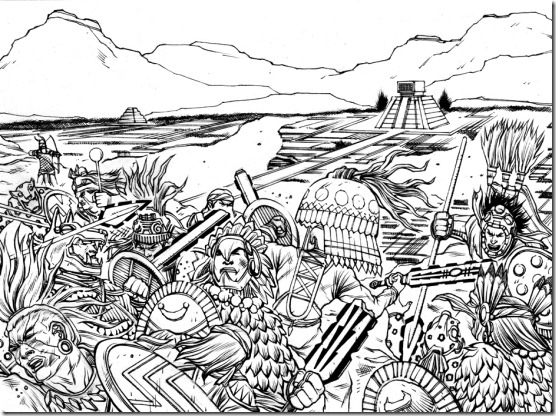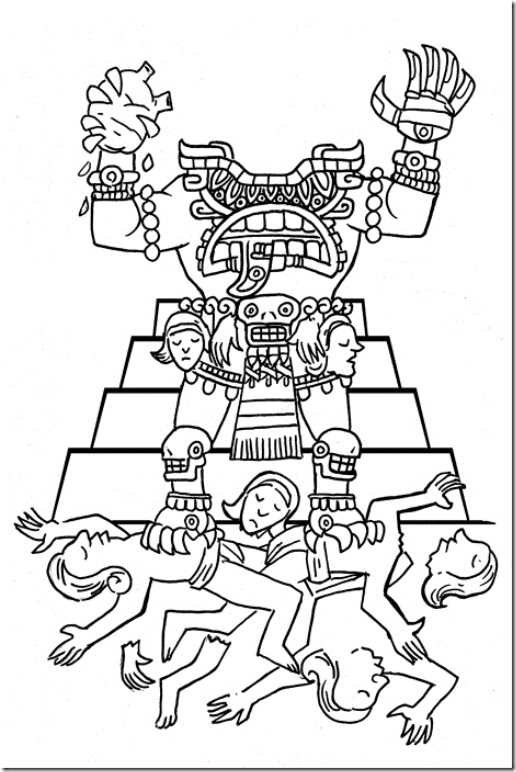 A couple of days ago I first heard about New Fire, a pen & paper RPG project on Kickstarter. That in itself is nothing special, because raising money on Kickstarter to fund your RPG has become quite common lately. What sets New Fire apart is its unique setting.
A couple of days ago I first heard about New Fire, a pen & paper RPG project on Kickstarter. That in itself is nothing special, because raising money on Kickstarter to fund your RPG has become quite common lately. What sets New Fire apart is its unique setting.
Jason Carminsky has created a fantasy RPG inspired by the history and mythology of the great Mesoamerican civilizations. The game is actually done and will be about 300 pages long. But one vital component is still missing: artwork. The goal of the Kickstarter projectis to raise enough money for artwork for New Fire. Luckily the goal of $3000 has been reached already and now the stretch goal is set at $6000 which are needed to commission color artwork.
I asked Jason if he was interested in answering a couple of questions for us and he was more than happy to do so.
Stargazer: Thanks again for taking your time time answer a few questions for us, Jason. Before we focus on New Fire can you tell us a bit about yourself? How did you get introduced to roleplaying games and what was the first game you have played?
Jason: The first RPG I ever played was Dragonstrike, an old stripped down version of Dungeons & Dragons designed for kids, skeptics, and the mathematically challenged. My best friend’s father ran it for a group of us kids back in the roaring ’90s. I can still remember the adventure: our party was supposed to escort an armored wagon carrying the evil sorcerer Teraptus through what was apparently a very rough part of town, seeing as how there were goblins and wolves prowling the streets and attacking us every other moment. Our goal was to bring Teraptus to the prison on the other side of the board within a certain amount of time, or else a red dragon would show up and kill us all.
We only vaguely knew what we were doing, however, so as soon as the first group of goblins attacked, one of the other players cast a web spell, which got everywhere and glued us all to the street. While we were struggling to get loose, the goblins killed the driver and crashed the wagon into a building. Teraptus got out and we spent the rest of the session trying to avoid him.
It wasn’t really until college that I started playing “seriously.” I fell in with a group that played DnD 3rd Edition in the dorms, and something about it just really resonated with me. It reminded me of playing as a kid, taking toys and sticks and whatnot and narrating my own stories, and I just couldn’t get enough of it. I’ve been playing continuously ever since.
Stargazer: Usually fantasy games are focused on settings inspired by medieval Europe or Asia. How did you come up with the idea of a setting based on Mesoamerican myths and history?
Jason: Honestly, I was just plain sick of fantasy Europe! I had been playing Europe-inspired fantasy for 6 or 7 years, and I was sick of swords and axes and wizards and clerics and undead and dragons. I was sick of thinly-veiled Judeo-Christian morality. I was sick of mounted vs unmounted combat mechanics, and of trying to come up with ways to represent leather, chainmail, and platemail armor. These things felt really stale to me, and I couldn’t find anything new to do or say with them.
However, around this time I began playing the Legend of the Five Rings RPG, which to this day is still my favorite RPG. I was very impressed by the interaction between history, myth, and fantasy in that game. It was inspired and well-researched, yet also highly original and personal. I was also amazed by its focus. Rather than haphazardly mixing a whole bunch of unrelated cultures and mythologies, L5R delved deeply into a relatively narrow group of cultures and considered them on their own terms, both mechanically and thematically.
That was really interesting to me. Every other game I had played had been designed such that Europe was the “norm.” Lots of games have included samurai classes and ‘foreign’ martial arts, and ‘exotic lands to the east.’ But these things are almost always compared to a European standard, and defined by how they differ from it.
L5R had its own self-defined normality. The setting and mechanics were designed around a completely different worldview, where concepts like samurai, bushido, and seppuku were not ‘weird’ or ‘exotic,’ but rather were accepted parts of the world, with a well-defined place in society and internally consistent meaning. The concepts were new to me, and that is why I found them so fascinating. But what was truly compelling was that they were not presented as being “new.” They were presented as normal. This challenged me, the Player, to adapt to the new normality, rather than simply catering to my existing biases and prejudices.
To make a long story short (too late!), I began to realize just how much we were all missing out on by focusing so exclusively on Europe-inspired fantasy. We were literally cutting ourselves off from not just a lot, but the vast majority of stories and storytelling traditions on Earth! That is the tricky thing about prejudice: it is so often completely unconscious. I wasn’t deliberately shutting out these other possibilities–they simply hadn’t ever occurred to me.
So one day, I decided to make a fantasy game inspired by Pre-Columbian Mesoamerica. I was browsing through images on Google, and came across some panels of the Aztec codices. I thought they were beautiful, and I was curious about what they meant. There’s really not much more to it than that. I was in a receptive frame of mind, I wanted to learn something new, to change and adapt, and I wanted to express it in game form. It was almost like boarding a plane to a random destination. In choosing Mesoamerica, I am tremendously happy with where I ended up!
Stargazer: How much research went into the creation of the setting? I understand that the setting is basically fantasy, but could it be used to learn more about ancient Mesoamerican cultures or at least get more people interested in them?
I have done a lot of research. I started about 2½ to 3 years ago, and am still learning new things to this day. I have read, watched, and listened to everything I could find about Mesoamerica. I have attended lectures by Professors and people of indigenous Mesoamerican descent, read stories and poetry, listened to music, worked in an archaeology lab, practiced flint knapping, and learned how to use an atlatl. I have tried my absolute best to educate myself, and to let the things I learned guide my imagination and inspire my ideas.
BUT
That does not make me any kind of authority on Mesoamerica, nor does it make New Fire a reliable source of real world information. I have done more research than many game designers end up doing on their games, but at most I have 2-3 years of study under my belt–not even enough for a Bachelor’s Degree.
Would you trust a person who has lived in your country for 3 years to speak with authority about your country? Probably not. How about somebody who has only researched your country for 3 years? Or how about somebody who has only researched the continent your country happens to be located on?
The only thing I truly know is that I have a lot more to learn.
I am extremely interested in Mesoamerica. I have found a lot of inspiration and wisdom researching it for New Fire, and I can honestly say that it has touched me and will influence the course of my life. But Mesoamerica has not been touched by me. I am not part of it. I was not born there and I have not lived there. I am an outsider, and you should not take anything you read in the New Fire book as fact.
New Fire is my interpretation of the information I have collected over these three years. It is a game about what I found, not a complete listing of what is there. I tried my best to do a good job, and I definitely hope my work inspires people to learn about and appreciate Mesoamerica. But New Fire is a fantasy game, not a teaching tool! It may awaken your interest, but it will not give you facts.
Stargazer: Can you give us an overview of the rules the game is using?
Jason: New Fire uses a unique set of rules I developed called the Sunstone system. Unlike many rulesets, there are almost no mandated rolls with Sunstone – so long as everybody is happy with how things are going, play progresses organically through roleplay and simple narration. You only need dice when there is a difference of opinion about where the story should go, when you have two or more people who want to narrate different outcomes to a situation. This is called a Challenge.
The basic idea is that, when someone’s narrative is challenged, they roll a pool of dice against a Target Number (TN). The results of these rolls are added together and compared to the TN The fewer dice it takes you to equal or exceed the TN, the greater your narrative control. If you hit the TN on a single die, you get complete narrative control – you can narrate anything you want, so long as everyone else in the group agrees that your narration is plausible and interesting (I refer to this as the ‘is it cool?’ test).
If it takes you 2 dice to hit the TN, you get narrative control but the challenger gets to specify a Condition that you must incorporate into your narration – for example, if you are attacking an enemy and the challenger sets the Condition ‘you cannot kill him,’ you must narrate a plausible outcome that does not result in the enemy being killed. Otherwise, it’s up to you – the enemy might be injured, or scared away, or even convinced to join your side, so long as he is not killed and so long as everybody agrees that it is plausible and interesting.
If it takes you 3 dice to hit the TN, the challenger gets to narrate, but you may specify a Condition. And if you cannot hit the TN even on 3 dice, the challenger gets complete narrative control.
Regardless of narrative control, however, you may not narrate the death of someone else’s character, nor can they narrate the death of your character. Only you can decide how and when your character dies.
The dice system works slightly differently in different situations (multiple challengers vs single challengers, for instance), and there are several other mechanics as well–Themes, Omens, Profession-specific Powers, Magic, etc – but this narrative dice mechanic is the foundation of New Fire’s rules, and probably covers 70% or more of the game.
Stargazer: On the Kickstarter page I read that in New Fire avoiding death is not the character’s ultimately goal, but dying in a meaningful and glorious way is. How exactly is this working in the game? What happens when one player’s character achieved their goal, but the other character’s haven’t?
Jason: One of the big ideas in New Fire is that the game world is sustained by death. In order for new life to grow, old life must die. This is where the practice of human sacrifice comes from – in order to keep the Sun rising, the rain falling, and the winds blowing, humans must die and release their life energy to the gods. If people stop offering these sacrifices, the cycles of nature will stop and the world will end.
This idea is reflected mechanically by something called the Bleeding Sun. At the beginning of a New Fire game Cycle, the Gamemaster will roll up a number of points of Day Energy. This total is kept secret from the players, but each session a number of these points will drain away. The Players may capture these points by fulfilling certain character goals and use them to improve their characters, but regardless, the Day Energy bleeds away each session. Eventually, there will be none left.
At this point, the Players must either sacrifice an NPC, or one of them must narrate the death of their character in order to restore the pool of Day Energy. Once this happens, the Game Cycle ends, and a new one begins. The Player whose character died creates a new character, and as a reward gets to choose the first Omen of the next Game Cycle (Omens are story guides for the Gamemaster — another mechanic that I probably don’t have time to get into here!).
Essentially, the story is driven by character deaths, which is kind of the opposite of most rpgs, where character deaths often completely end the story! Characters do not come to the world to stay — they are merely passing through. The important part is what they do while they are there, and how they choose to leave. And because only the Player can narrate the death of his or her character, it encourages/requires them to consider what their character’s life (and by extension their own life) really means.
In many ways, the story IS the world. Each group will tell its own stories and interpret the written world in its own way, much like multiple families living in the same house–though it is the same building, each family’s home and home life will be very different, filled with different experiences, different furniture, and different triumphs and tragedies. The story/world in New Fire is created by the group and kept alive by their efforts. They all contribute to it, and they all work to sustain it.
And when the Players are no longer interested in sacrificing their characters to keep the story going, it, and the world, end.
Stargazer: What do you plan for the future of New Fire? Do you have already a couple of supplements, adventures etc. planned?
Jason: I am pretty focused on this first release at the moment, and it is keeping me plenty busy! But assuming it goes well, I definitely have many more ideas for New Fire. One idea that has been getting a lot of attention so far is a supplement called Journey of the Dead, which will contain rules for games that take place not in the main New Fire world, but in the Underworld.
When a person dies in New Fire, they embark on a long, difficult journey through the dark and frightening Land of the Fleshless beneath the Earth. This journey is full of dramatic struggle and complex symbolism — in many ways the dead are experiencing the reverse of birth, traveling back into the Earth-womb and becoming un-made. Normal New Fire focuses on the land of the living, but Journey of the Dead would contain rules for how to follow the characters beyond that.
I haven’t yet decided whether Journey of the Dead will take place entirely in the Underworld, or if it will include rules for “split parties,” where some characters are living and some are dead, but I think there are a lot of interesting possibilities with this, and am excited to get to work on it!
I discuss a few other ideas on the New Fire Kickstarter page, and encourage people to check them out and let me know what they think! But I don’t want to get too ahead of myself before this first book is released, so why don’t we leave it at that for now!
Stargazer: Thanks again for giving us this interesting insight into your upcoming game New Fire!
If you want to learn more about New Fire, feel free to post your questions below. I’m sure Jason would be more than happy to answer them for you. And if you want to get more details on the Kickstarter project check out the project site here.
Please note that the artwork illustrating this post has been created for the New Fire RPG and was used with Jason’s permission.




